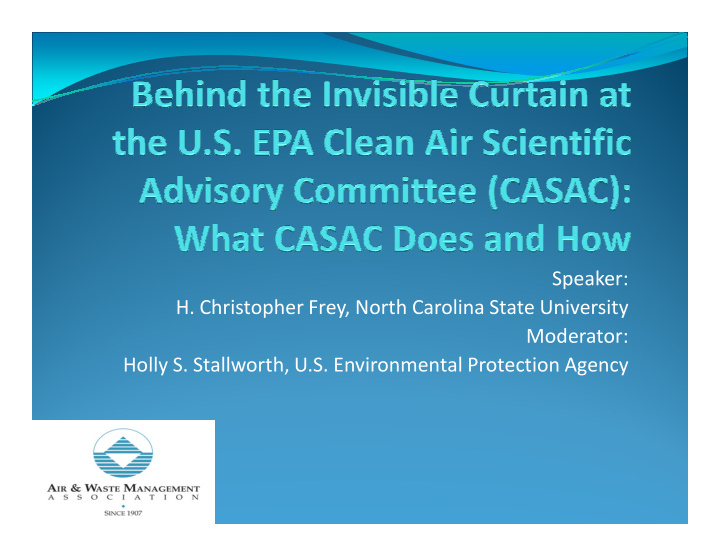



Speaker: H. Christopher Frey, North Carolina State University Moderator: Holly S. Stallworth, U.S. Environmental Protection Agency
Presenter Bio Dr. H. Christopher Frey is Distinguished University Professor of Environmental Engineering in the Department of Civil, Construction, and Environmental Engineering at NC State. His research activities are in: measurement and modeling of real-world fuel use and emissions of onroad and nonroad vehicles; measurement and modeling of human exposure to air pollutants; environmental risk analysis, quantification of sensitivity, uncertainty, and variability in systems models; and and modeling and evaluation of energy and environmental control systems. He is Chair of the EPA Clean Air Scientific Advisory Committee and has previously served on CASAC review panels for all six criteria pollutants regulated under the National Ambient Air Quality Standards. He is past president and a fellow of the Society for Risk Analysis and a fellow of the Air & Waste Management Association. Dr. Frey has a B.S. Mechanical Engineering from the University of Virginia, and from Carnegie Mellon University he has a Master of Engineering in Mechanical Engineering and PhD in Engineering and Public Policy.
Moderator Bio Dr. Holly Stallworth is an economist in EPA’s Science Advisory Board Staff Office. She has been at EPA since 1980 and Designated Federal Officer (DFO) for the Clean Air Scientific Advisory Committee (CASAC) since 2009. In that capacity, she has managed the chartered CASAC as well as some of its panels, including panels on ozone, particulate matter and oxides of nitrogen and sulfur. As DFO, she recruits scientists who serve on the chartered CASAC as well as CASAC panels. She also assists the Chair in drafting and editing CASAC reports so that they clearly reflect CASAC’s consensus response to EPA’s charge questions. Finally, she is responsible for the day-to-day administration of CASAC, ensuring that the requirements of the Federal Advisory Committee Act (FACA) are met through open meetings announced in the Federal Register, posting minutes on the CASAC website (www.epa.gov/casac) and providing opportunities for public comment at CASAC meetings.
Behind the Invisible Curtain at the U.S. EPA Clean Air Scientific Advisory Committee (CASAC): What CASAC Does and How H. Christopher H. Christopher Frey Frey Department of Civil, Construction, and Environmental Engineering North Carolina State University Raleigh, NC 27695 Prepared for: Air & Waste Management Association January 8, 2014
DISCLAIMER • These are my personal views • They do not represent any official position of U.S. Environmental Protection Agency (EPA) or the EPA Clean Air Scientific Advisory Committee (CASAC) 5
Overview • Statutory Mandate: NAAQS, CASAC • CASAC’s Charter • NAAQS Review Process • CASAC Meetings • Appointment of Members: CASAC, Panels • FACA and CASAC • Scope of CASAC • CASAC, NAAQS and the Courts • EPA Inspector General’s Report • Summary of Recent CASAC Activities 6 • Broad Science-based Issues
CASAC • Clean Air Scientific Advisory Committee (CASAC) • Independent advice to the EPA Administrator on technical bases for National Ambient Air Quality Standards (NAAQS). • Established in 1977 under the Clean Air Act (CAA) Amendments of 1977 7
Statutory Mandate for National Ambient Air Quality Standards • Section 108 of Clean Air Act –Identify and list certain air pollutants –Issue air quality criteria for those pollutants. –In Administrator’s “judgment, cause or contribute to air pollution which may reasonably be anticipated to endanger public health or welfare ;” –“the presence of which in the ambient air results from numerous or diverse mobile or stationary sources ;” –“ accurately reflect the latest scientific knowledge ” 8
National Ambient Air Quality Standards: “Primary Standard” • “the attainment and maintenance of which in the judgment of the Administrator, based on such criteria and allowing an adequate margin of safety , are requisite to protect the public health .” –Intended to address uncertainties –Reasonable degree of protection –Does not require zero risk –Interpretation has been reviewed in numerous court cases 9
“Adequate Margin of Safety” Factors considered by EPA: • nature and severity of the health effects • size of sensitive population(s) at risk, and • the kind and degree of uncertainties 10
National Ambient Air Quality Standards: “Secondary Standard” • “specify a level of air quality the attainment and maintenance of which, in the judgment of the Administrator, based on such criteria, is requisite to protect the public welfare from any known or anticipated adverse effects associated with the presence of [the] pollutant in the ambient air.” • “Welfare” generally refers to endpoints other than human health. Examples – Ecological impact – Reduction in visibility – Damage to materials 11
Cost and Standard Setting • In setting a NAAQS, EPA may not consider costs of implementing the standards (Whitman v. American Trucking Associations, 2001). • “[a]ttainability and technological feasibility are not relevant considerations in the promulgation of national ambient air quality standards.” (American Petroleum Institute v. Costle) 12
Key Elements of a NAAQS •Indicator (Pollutant) •Level •Averaging Time •Form 13
������������������������������������������������������� ������������������ �������� ��������� � ���!��!�"��� #� �� $��� ��������� ������ ����� ��� ������� ������������������������������������������ ������ ������ ������������ ���������������� #��� ����� �!� � ������������������ ��������� ������� ������������ "����� ������ "���������� ��������� �� �� �� �� ������������#���������������������� ������� ������ ������� ��������������$���������������������� ������������ "������#���������������������������� � �� ������ ���%����� ��������� ������������������$���������������������� ������� �&��� �!� � "����� �����������$���������������������� ��������� ����� �!� � �% �&' ������������ �� �� ����������$���������������������� &'����� ��� �!� � ��������� ������������ ������������������������������������������� �% ��� &'����� ���� �!� � ��������� ����������������������� �� �� ������������#���������������������� ������� ������ %����� ��������������$���������������������� �� � ��������� ������ ������� ������������������������������������������ (�������)������������*���������������)+��#���������*�������������,������#�������������������������������)���*$������������������ )���*������������������� �������������#�����) �!� � *���-����������#����������������������������$�����������.!!+++��������!���!���/�!� 14
Statutory Mandate for Five Year Review Cycle • Section 109(d)(1) requires that “not later than December 31, 1980, and at 5-year intervals thereafter, the Administrator shall complete a thorough review of the criteria published under section 108 and the national ambient air quality standards . . . and shall make such revisions in such criteria and standards and promulgate such new standards as may be appropriate . . . .” 15
Recommend
More recommend